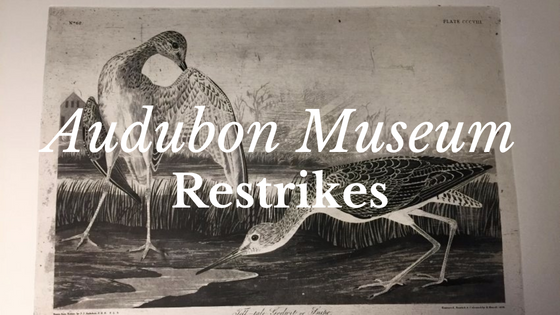Now available for sale on the Friends of Audubon online shop are restrikes of the Tell-tale Godwit taken from the original copper engraving plate of John James Audubon’s Birds of America. UPDATE: restrikes of the American Bittern are now sold out.
In 2002 and 2013, the Friends of Audubon issued limited edition restrike prints from the museum’s original copper plates of the Tell-tale Godwit, or Snipe and the American Bittern by John James Audubon. A few restrikes of the Tell-tale Godwit continue to be offered by the Friends of Audubon for a minimum donation of $1,000 with the proceeds designated for the conservation of the museum collection and new acquisitions. A charitable donation certificate in the amount of $500 will be issued for each restrike purchased. Any additional donation for the print in excess of the $1,000 will also be recognized as a charitable contribution to this worthy cause.
You may reserve your limited edition Tell-tale Godwit restrike by contacting Audubon Museum curator, Heidi Taylor-Caudill, at 502-782-9716 or heidi.taylorcaudill@ky.gov. Please contact her to schedule pick-up or shipping arrangements, and feel free to reach out if you have any questions.
The Copper Engraving Plates

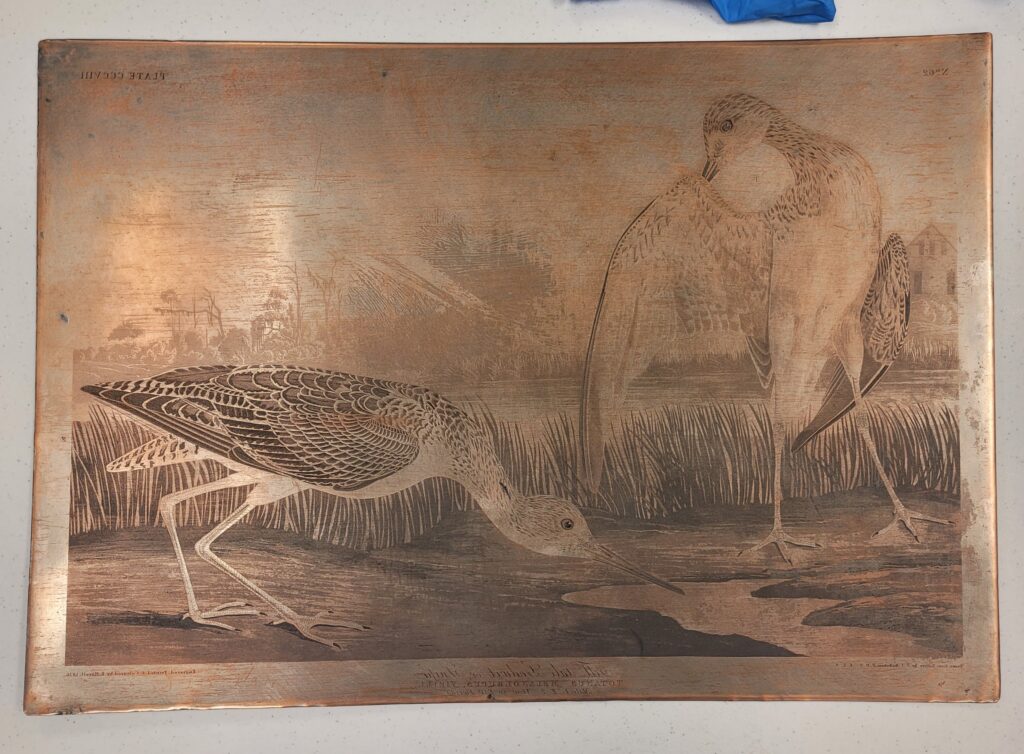
The publication of John James Audubon’s groundbreaking work, The Birds of America, was made possible only with the technological input and expertise of others. Among those were two skilled engravers. William H. Lizars of Edinburgh produced the first ten images and Robert Havell, Jr. of London, the remaining 425. Robert Havell, Jr. was, in his time, one of the most accomplished engravers in Europe. He was an expert in the technique known as “aquatint.” His brother, Henry Havell, also played a very important part. It was Henry who traced the outlines of Audubon’s original watercolor paintings onto tracing paper. The paper was then placed face down on a sheet of copper coated with a thin layer of wax. Robert cut the image through the wax and etched the plate in acid to establish the engraving. Following this step, Robert began to fill in the shadows and shading, giving the image its three dimensional effect. The delicate shading as seen in the foreground was done by aquatint. Aquatint is accomplished by coating an area of the copper plate with a resin. The plate is then heated causing the resin to crack, opening up minute voids in the resin coating which when again exposed to acid, etched the copper according to the width and pattern of those voids. With expert control of this process Robert Havell, Jr. was able to create the remarkable effects seen on the plates and prints made from them. This whole process, called intaglio printing, uses the engraved, etched, and aquatinted copper plate to strike the black outline and detail of the image, which is then hand colored. The production took 12 years to complete a total of 435 separate images for The Birds of America.
When the publication was completed in 1838, Audubon and his family returned to America. The copper plates were stored in a warehouse until 1845 when a fire destroyed the structure and damaged several of the plates. At that time the remaining plates were taken to the Audubon estate and stored in an outbuilding called “the cave.” Following the deaths of Audubon and their two sons, Audubon’s widow, Lucy, attempted to pay off family debts by selling her home, Audubon’s watercolor paintings, and finally the copper printing plates. When a buyer could not be found the plates were consigned to a metal dealer. After a few years, that dealer, unable to find a buyer, decided to melt the plates as scrap. On that day, William Cowles, the fourteen-year-old son of the foundry manager, happened to observe what was happening. With the help of his mother, they stopped the destruction in time to save approximately 80 of the plates. Several of the plates were then gifted to the owners of the foundry, museums, and individuals, including one of Audubon’s granddaughters.
Plate 308: The Tell-tale Godwit, or Snipe
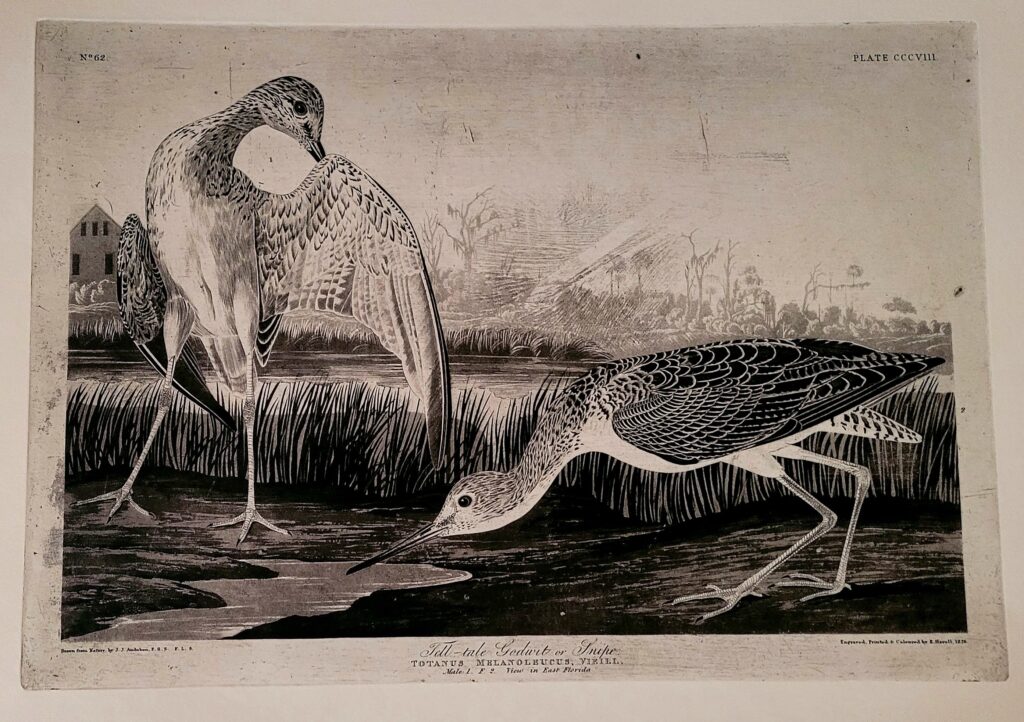
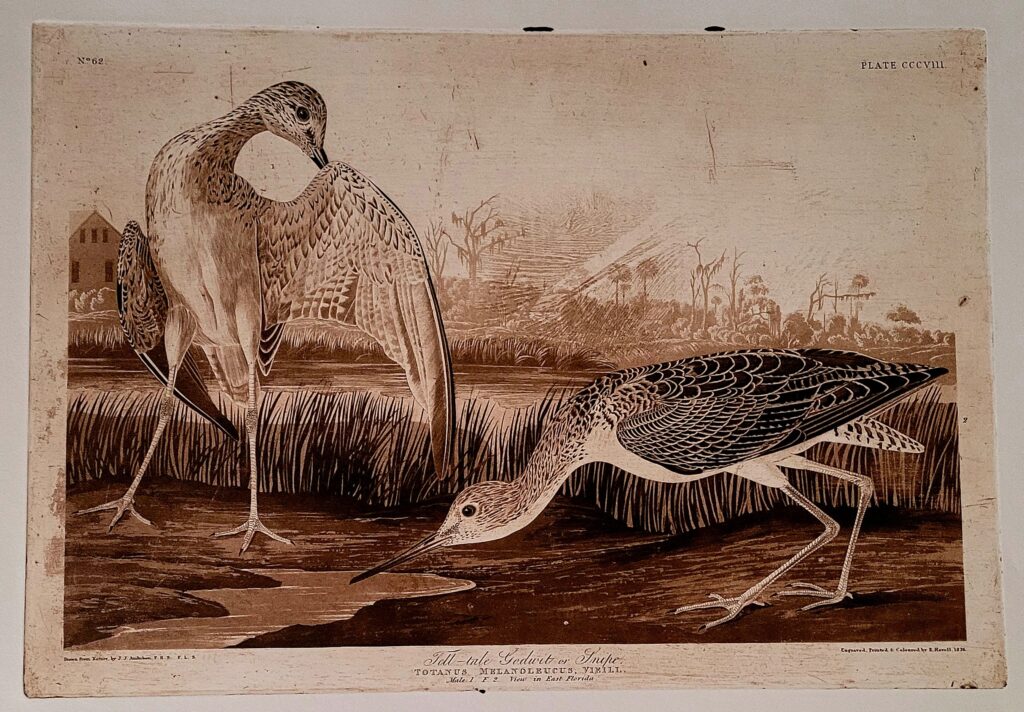
The plate used to produce this image came to the Audubon Museum in Henderson, Kentucky, through the descendants of the original engraver, Robert Havell, Jr. Though there is no record, it seems very likely the foundry owners may have presented it to one of Havell’s grandchildren. Audubon painted the two birds (“Tell tale Godwits”) wading in a marsh on the Halifax River near St. Augustine, Florida, in 1832. Audubon’s assistant, Swiss artist George Lehman, created the background showing the Bulow Plantation.
This restrike print is one of a limited edition of 107 released by the Friends of Audubon of Henderson, Kentucky. The Friends of Audubon had originally anticipated printing 250 restrikes, but the printing process was stopped at 107 after damage to the copper plate became evident. The prints are still numbered as an edition of 250. Each restrike print is authenticated by the presence of Audubon’s seal in the lower left corner. The printing was done on archival paper completely by hand by Professor Michael Aakhus of the University of Southern Indiana in Evansville, Indiana.
Plate 337: American Bittern (Restrike Sold Out)
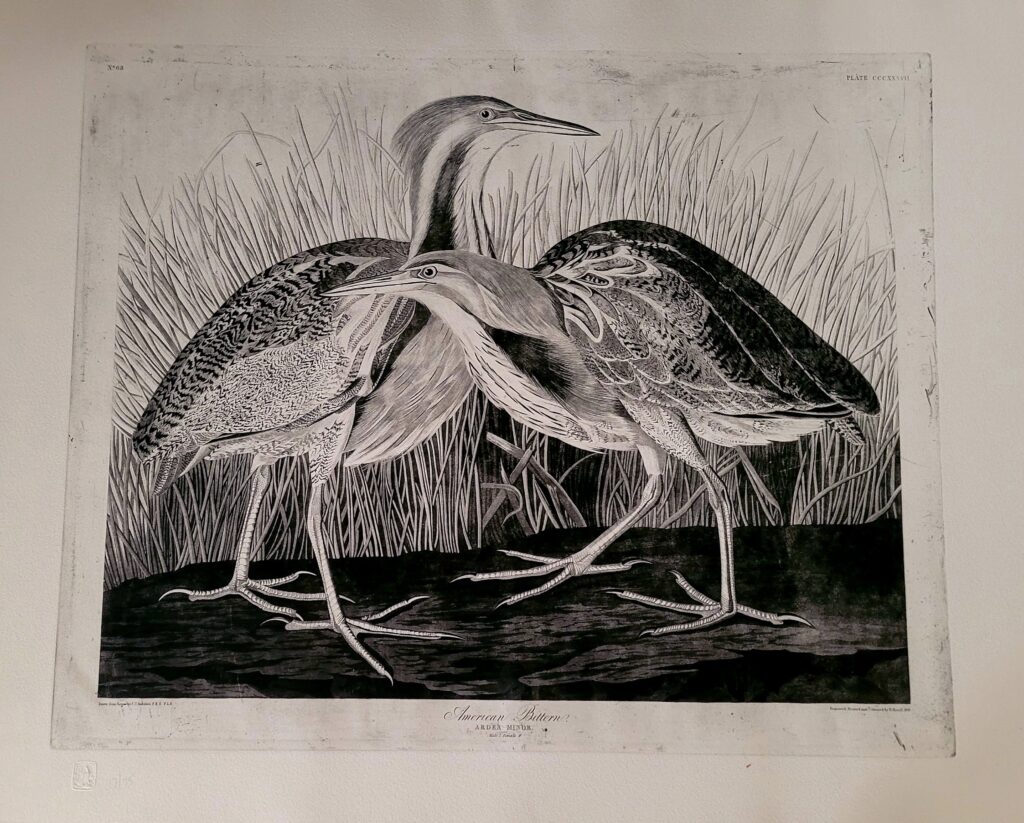
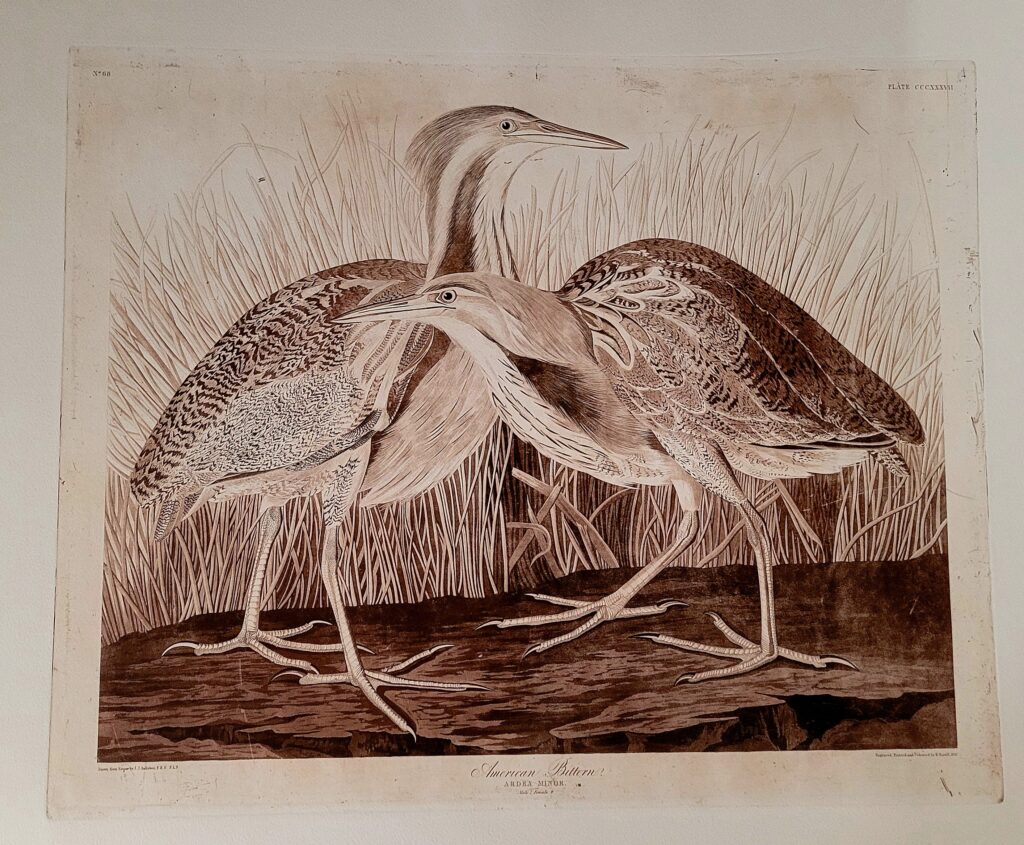
The plate used to produce this image of the American Bittern (#337) came to the Audubon Museum through a purchase by the Friends of Audubon in 2007. It shows two birds standing on a muddy bank against a background of marsh grass. According to Audubon, the engraving for this plate was based on a painting done by his son, John Woodhouse Audubon, along the Atlantic coast in 1832 or 1833. This is disputed in Audubon circles. A comparison of the artistic styles of father and son suggests that John Woodhouse painted the background and the birds’ feet. It seems likely that John James Audubon was attempting to promote his son’s maturing artistic talent. Audubon obtained specimens of this bird from many locations during his travels, but he remarked that “it was never my fortune to have a good opportunity of observing all the habits of this remarkable bird” which he characterized as “extremely timid.”
Although unaccounted for by the Audubon academic world for over 100 years, the American Bittern plate was among the fortunate plates to have been salvaged from the foundry’s fire. Purchased by the Whitlaw Reid family in the 1920s, the Bittern plate was given to a grandson, Whitelaw Reid II, in 1926 for his sixteenth birthday. For the next 80 years, it hung over the doorway in the playhouse cabin at the Reid’s Adirondack camp. In 2007, the family offered the plate to the Friends of Audubon to become a spectacular addition to the Audubon Museum’s collection, thus establishing the American Bittern as the 80th original Audubon copper engraving plate known to still exist.
To celebrate the 75th anniversary of the founding of John James Audubon State Park, the Audubon Museum and the Friends of Audubon in partnership with Professor Michael Aakhus of the University of Southern Indiana arranged to pull restrikes from this rare plate. The Friends of Audubon released a limited edition of 75 prints for sale. Each restrike is authenticated by the presence of Audubon’s seal in the lower left corner. The printing was done on archival paper completely by hand by Professor Michael Aakhus of the University of Southern Indiana in Evansville, Indiana.
Sale Proceeds
Friends of Audubon is a private non-profit group whose purpose is to support the Audubon Museum at John James Audubon State Park. All funds from restrike sales are used for conserving the Audubon Museum’s art collection.
Frequently Asked Questions
What is a restrike?
In this case, a restrike is a print that was later pulled, or restruck, from an original copper engraving plate used to make The Birds of America double elephant folio without the involvement of the principal people behind the publication, which would be John James Audubon and his engraver Robert Havell, Jr.
Who made the Audubon Museum restrikes?
The Audubon Museum partnered with artist Michael Aakhus, who is a Professor of Art and Dean Emeritus of the College of Liberal Arts at the University of Southern Indiana in Evansville, Indiana. You can learn more about him on his website: https://www.aakhusart.com/.
How many restrikes were pulled of the Tell-tale Godwit plate?
The Audubon Museum and Professor Aakhus made 107 restrikes of the Tell-tale Godwit in 2002. 56 of these were done in black ink and 51 in sepia. All even-numbered prints of the Tell-tale Godwit are sepia and odd-numbered prints are black with one exception: numbers 103-107 are black.
Why did the Audubon Museum stop with 107 restrikes of the Tell-tale Godwit?
During the printing process of the Tell-tale Godwit, museum curator Don Boarman noticed damage to the copper plate and decided to make no more restrikes. The museum had anticipated to print 250 restrikes (125 sepia, 125 black), which is why the prints are numbered that way.
How many restrikes were pulled of the American Bittern plate?
The Audubon Museum and Professor Aakhus made 75 restrikes of the American Bittern in 2013. 50 of these were done in black ink and 25 in sepia.
Which color of restrikes is the most popular?
Most people seem to prefer the black restrikes.
What kind of paper was used for the restrikes?
The restrikes were made from sheets of ARCHES® 300 gsm paper imported from England.
Can you describe the ink used for the restrikes?
The ink was a commercially-available ink used for printmaking. It had the consistency of tar and was composed of at least three components: a powdered pigment, linseed oil, and varnish.
What is the size of the restrikes?
The size is 38.5 inches high x 29.5 inches wide – just like the double elephant folio paper that Robert Havell, Jr. used for printing the The Birds of America.

